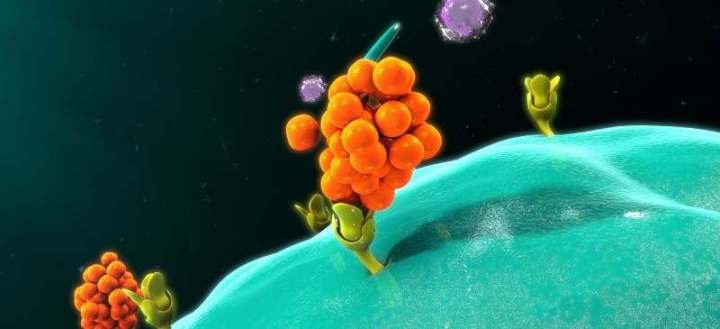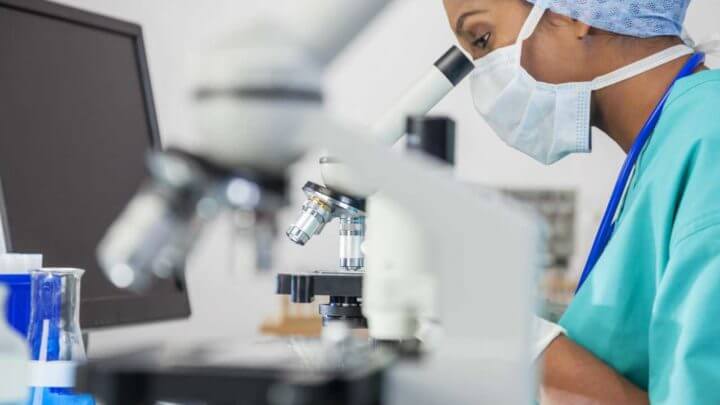Surely you have heard of cytokines , especially if you have heard the effects that COVID-19 can cause, but you really do not understand well how they work in the human body or their relationship with the immune system .
In order for everyone to understand it, it can be said that they are proteins in charge of transmitting the messages that are emitted between some cells and others to carry out specific missions. To give you a better understanding of the concept and its function, we will talk more about cytokines and their role in the immune system .

What are cytokines?
Cytokines are low molecular weight proteins that cells make. They serve to transmit messages between them depending on what our body needs. They act through complex interactions between different types of cells.
They are also part of the immune system. Its operation is as follows: imagine a small molecule, which is produced by a cell that receives a stimulus. This molecule travels to its receptor (found on another cell) to deliver a signal or message (these receptors are found on cell membranes). This second cell will give an answer, and from there a cascade of signals begins in the human body. This cascade will trigger a specific biological response.

Cytokine characteristics
Cytokines are very different and very complex molecules, although they share a number of characteristics.
A part of the immune system, produced mostly by s on macrophages, which are essential molecules in the innate immune system. Remember that the innate immune system is the one that implies that cells recognize pathogens in a generic way and attack them.
If we talk about a specific immune system, helper T cells are responsible for producing cytokines. The specific immune system is one that, as its name indicates, has specificity. This means that the cells attack specific pathogen receptors.
Cytokine production is relatively brief (transient) and is dependent on the duration of the stimulus (ie, the pathogen in the case of macrophages and T cells).
In addition to the above, there are other characteristics of cytokines . For example, they have pleiotropy, that is, they trigger multiple effects after acting on different cells. They are also redundant. This means that different cytokines can produce the same effect . They can also be synergistic, causing an effect that is enhanced between them; and they can be antagonistic, that is, they can block each other.

Cytokine classification
There are several classifications of cytokines , since these are very complex molecules, with different origins and different functions. These are the main ones:
1. According to the interaction
Basically, the interactions are between lymphoid cells (cells of the immune system), inflammatory cells, and hematopoietic cells (cells of the blood). But these interactions can be of different types, and based on these types, we get one classification or another:
1.1 Autocrine
They are those cytokines that act on the same cell that produces them.
1.2 Paracrines
They are those cytokines that act in the region adjacent to the site of secretion.
1.3 Endocrine
They are those that act in distant regions from where they have been secreted. These cytokines travel through the blood and their function is to act on different tissues.

2. According to its function
Cytokines, being such diverse and complex molecules, can perform widely varied functions. In this section we will talk about the most outstanding ones.
2.1 Pro-inflammatory function
They belong to the pro-inflammatory cytokines . They act on the innate, nonspecific immune response or inflammation.
2.2 Developmental function, cell maturation, and / or cytooxicity
These proteins act at different times in the cell cycle to model the development, maturation and / or death of cells.
2.3 Producing functions of different immunoglobulins
They are the proteins that protect us from infection .
2.4 Hematopoietic functions
They are those cytokines involved in the development and maturation of blood cells (red blood cells, white blood cells and platelets, essentially).

Cytokine receptors
Taking all the above into account, we can be aware that cytokines must interact with a receptor on a cell to trigger a response.
There is a wide variety of cytokine receptors . These receptors are the ones that will determine the response that the effector cell will trigger. This variety of receptors is grouped into the 5 families of cytokine receptors .
Immunoglobulin superfamily
They are the receptors for the well-known antibodies , which are the essential molecules that the body creates to specifically attack pathogens .
Class I family of cytokine receptors
This family of receptors constitutes the hematopoietin receptors, that is, of the blood cells.
Class II family of cyto receptors
This family of receptors constitutes the interferon receptors. The latter are proteins that the body makes in response to pathogens (viruses, bacteria or parasites, among others).
TNF receptor family
They are the molecules that mediate the processes of inflammation and cell death.
Chemokine receptor family
This last group of cytokine receptors are especially peculiar. They are so named because they are able to attract and direct other cells of the immune system to repair tissues.
Of all these "superfamilies" mentioned, there are various subgroups of each. In this way, each superfamily is involved in specific molecular mechanisms.

Types of cytokines
There are different classes of cytokines , each with multiple biological functions. The latter can be similar or antagonistic. Furthermore, the same cytokine may also have a specific function on one type of cell and a completely different function on another.
Cytokines can be divided into several groups , depending on their activation context or the class of cells that produce them, for example. We will see some of them below.
Interleukins (IL)
They are mainly responsible for regulating the activation of cells of the immune system and for controlling the differentiation and proliferation of some cell subpopulations. Some have pro-inflammatory functions and others anti-inflammatory. They also activate the endothelium and increase vascular permeability, facilitating the migration of immune cells from the bloodstream into the tissue. They also promote the secretion of antibodies and control the response of T lymphocytes.
Tumor necrosis factors (TNF)
They are important cytokines during the early stages of the inflammatory response. They are produced by a wide variety of cells and play a central role in viral infections , as well as in cell proliferation and death.
Interferons (IFN)
Interferons play an important role in the innate response to viruses or other pathogenic microorganisms . They are, therefore, secreted as danger signals: they promote antiviral activity and the activation of Natural Killer cells .
Colony stimulating factors (CSF)
They are growth factors. They stimulate the differentiation and proliferation of stem cells to cells of the immune system, for example. They have functions associated with inflammation and the production of other cytokines.
Chemokines
They stimulate the motility of the cells of the immune system. In addition, they direct them, for example, towards the site of inflammation, through a phenomenon called chemotaxis .

Cytokines and modern medicine
Cytokine power lies in our ability to manipulate or stimulate its production in order to l chieve a certain positive biological response for our body. Knowing how they work, when they occur and, most importantly, what biological response they trigger, is revolutionizing the treatments of modern medicine.
Cytokine therapy
Achieving a balance of cytokines is essential , not only in the fight against autoimmune diseases, but also in maintaining health. This balance is evident when one takes into account that although pro-inflammatory cytokines are related to cancer, anti-inflammatory cytokines are used in cancer immunotherapy .
By synthesizing them in a laboratory, more interleukins (anti-inflammatory cytokines) can be generated than are produced by our body. In this way, interleukin 2 (IL-2) stimulates the production of antibodies , while a similar cytokine, interferon alpha (IFN-α), helps regenerate immune cells that have stopped functioning .

Balance between cytokines
Fortunately, many of us naturally produce a healthy balance of cytokines through our diet. People on a gluten-free diet will benefit from a better balance. This is because gluten could be related to stimulating an inflammatory response. In addition, superfoods promote the production of anti-inflammatory cytokines , which makes them valuable supplements in our diet.
While our food choices help produce beneficial cytokines, stress can cause our nervous systems to block their anti-inflammatory functions. Good stress management is essential to ensure a healthy and natural production of this protein, and to improve our health in general.